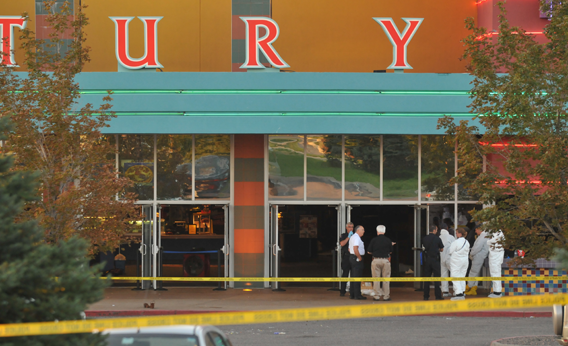Viral Violence
Do violent attacks occur in clusters?

Photograph by Thomas Cooper/Getty Images.
On Friday, a masked gunman fired into the audience at a midnight screening of The Dark Night Rises, killing 12 moviegoers and wounding 59 others in Aurora, Colo. Aurora lies about 13 miles from the town of Littleton, the location of the 1999 Columbine High School massacre. Does violence occur in clusters?
It can. In fact, episodes of violence seem to cluster in space, in time, and in the type of target. Programs such as CeaseFire and the Violence Prevention Alliance compare violence to disease because it proves contagious (one act of violence often begets another), and because it moves in epidemic-like cycles. It can manifest in acute outbreaks—genocides, gang wars, class riots—or in long-term patterns of aggressive behavior. Studies show that those who suffer abuse as children may carry the latent “illness” for years before visiting symptoms upon their own kids. And much as cholera spreads through dirty water and crowding, violence perpetuates itself when we observe it happening or when we experience it ourselves. Nancy Guerra and L.R. Huesmann have teased out ways in which brutality against partners and children can lead to violence against acquaintances and strangers, and eventually to widespread violence in a community. And Albert Bandura’s social learning theory provides insight into how humans model their behavior on the actions of others, so that a city immersed in angry confrontations might be seen to feed its own fever.
Mass murder represents a specific and ghastly kind of violence. It differs from “normal” bloodshed (as well as from killing sprees or serial murders) in that it involves three or more victims, takes place in one location, and occurs as part of a single episode. Perpetrators tend to be enormously stressed and psychologically disturbed. Their desperation may leave them especially vulnerable to the “imitation” effect, meaning that reports of carnage may inspire their own plans or trigger them to act.
A summary of research on mass murder (PDF) by the Center for Public Safety Initiatives notes waves of killings unfolding in the 1920s, 1930s, 1980s, and 1990s From 1986 to 1995, more than 40 people were murdered either in post offices or at the hands of postal workers. (The Los Angeles Times was among the first to use the phrase “going postal” to describe a sudden eruption of deadly anger.) At the turn of the century, a slew of school shootings transformed the classroom into a new bulls-eye for gun violence. The Columbine mass murder, during which 12 students, one teacher, and the two gunmen died, and the Virginia Tech massacre of 2007, which claimed 32, were among many attacks that unfolded on school campuses.
Some clusters of violence have been linked to a space’s particular culture. For instance, many of the post office perpetrators fit a “disgruntled employee” profile: They had been laid off, felt underappreciated, or sought revenge on a particular supervisor. (Concerns about systematic flaws in the USPS working environment led the agency to train a cohort of analysts who could monitor office life for postal workers. Because of downsizing, the program was eliminated in 2009, after a 16-year run.) One author has even speculated that the workplace shootout is the new slave rebellion, reflecting discontent in the wake of Reagan’s trickle-down economic policies. As for school murders, the kids who are most likely to open fire on campus usually suffer from social alienation. Whether movie theaters have any inherent qualities that might attract continued violence remains murky. If multiplex shootings do become a new meme for mass murderers, we’ll probably have the copy-cat effect to thank.
One other factor may explain violence “hotspots.” Research suggests that most street-level violence stems from arguments and disputes—interactions in which one person feels snubbed and tries to regain status through physical force. (That business concerns, or “turf wars,” unleash waves of urban violence is a bit of a myth. In the drug trade, dealers rarely have to worry about finding customers, so from a financial perspective, the competition for a particular corner or sale zone is less vicious than The Wire would have us believe.) Personal confrontations tend to escalate, inviting reprisals and eventually creating a shift in climate. As public spaces accrue a sense of threat, people begin to carry guns. (And in fact, though violent crime rates in the United States continue to sink, a late 2011 study found that most Americans believe the country is growing less safe, which may help explain the FBI’s report of record gun sales that same year.) Conversely, when effective deterrence policies are in place, violence declines, first in a trickle, and then in a steep drop. This is because the estimated risks of packing a firearm—arrest, accidental discharge—start to outweigh those of wandering the streets without a weapon.
Explainer thanks John M. Klofas of the Center for Public Safety Initiative, and Gary Slutkin of the University of Illinois at Chicago School of Public Health.
Got a question about today’s news? Ask the Explainer.
Video Explainer: How Much Gold Leaf Can You Safely Consume?
This video was produced from an original Explainer by L.V. Anderson.
Want more questions answered? You can now watch video Explainers at Slate's News Channel on YouTube.
